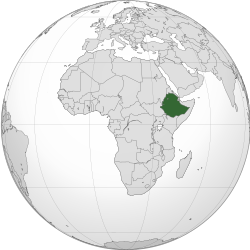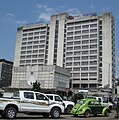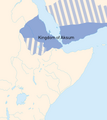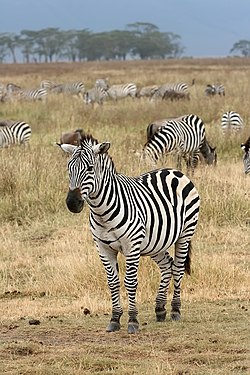Introduction
Federal Democratic Republic of Ethiopia የኢትዮጵያ ፌደራላዊ ዴሞክራሲያዊ ሪፐብሊክ (Amharic) | |
|---|---|
| Anthem: [ወደፊት ገስግሺ ፣ ውድ እናት ኢትዮጵያ] Error: {{Lang}}: invalid parameter: |bold= (help) (English: "March Forward, Dear Mother Ethiopia") | |
 | |
| ISO 3166 code | ET |
Ethiopia, officially the Federal Democratic Republic of Ethiopia, is a landlocked country located in the Horn of Africa region of East Africa. It shares borders with Eritrea to the north, Djibouti to the northeast, Somalia to the east, Kenya to the south, South Sudan to the west, and Sudan to the northwest. Ethiopia covers a land area of 1,104,300 square kilometres (426,400 sq mi). As of 2024[update], it is home to around 132 million inhabitants, making it the 10th-most populous country in the world, the 2nd-most populous in Africa after Nigeria, and the most populated landlocked country on Earth. The national capital and largest city, Addis Ababa, lies several kilometres west of the East African Rift that splits the country into the African and Somali tectonic plates.
Anatomically modern humans emerged from modern-day Ethiopia and set out for the Near East and elsewhere in the Middle Paleolithic period. In 980 BC, the Kingdom of D'mt extended its realm over Eritrea and the northern region of Ethiopia, while the Kingdom of Aksum maintained a unified civilization in the region for 900 years. Christianity was embraced by the kingdom in 330, and Islam arrived by the first Hijra in 615. After the collapse of Aksum in 960, the Zagwe dynasty ruled the north-central parts of Ethiopia until being overthrown by Yekuno Amlak in 1270, inaugurating the Ethiopian Empire and the Solomonic dynasty, claimed descent from the biblical Solomon and Queen of Sheba under their son Menelik I. By the 14th century, the empire had grown in prestige through territorial expansion and fighting against adjacent territories; most notably, the Ethiopian–Adal War (1529–1543) contributed to fragmentation of the empire, which ultimately fell under a decentralization known as Zemene Mesafint in the mid-18th century. Emperor Tewodros II ended Zemene Mesafint at the beginning of his reign in 1855, marking the reunification and modernization of Ethiopia. (Full article...)
Selected article -
(Full article...)
Selected biography -
Susenyos I (Ge'ez: ሱስንዮስ Sūsinyōs; c. 1571–1575 – 17 September 1632), also known as Susenyos the Catholic, was Emperor of Ethiopia from 1607 to 1632, and a member of the Solomonic dynasty. His throne names were Seltan Sagad and Malak Sagad III.
He was the son of Abeto Fasil, as well as the grandson of Abeto Yakob and the great-grandson of Dawit II. As a result, while some authorities list Susenyos as a member of the Solomonic dynasty, others consider him—rather than his son, Fasilides—as the founder of the Gondar line of the dynasty (which is, however, ultimately a subset of the Solomonic dynasty). (Full article...)
General images -
Related portals
Geography
Countries
WikiProjects
Main WikiProject
Related WikiProjects
Africa • Countries • Eritrea • African military history task force
Things you can do
- Visit the Ethiopian Wikipedians' notice board.
- The noticeboard is the central forum for information and discussion on editing related to Ethiopia.
- Comment at the Ethiopian deletion sorting page.
- This page lists deletion discussions on topics relating to Ethiopia
Selected pictures
Did you know -

- ... that Liberian paramount chief Tamba Taylor worked as a tailor and claimed to have sewn clothes for Ethiopian emperor Haile Selassie and Ghanaian president Kwame Nkrumah?
- ... that Quintin Johnstone advocated giving control of an American-governed law school to native Ethiopians?
- ... that the government of Ethiopia's SNNP Region supported local governments calling for a referendum to secede from the region?
- ... that Aguil Chut-Deng took 22 child refugees from South Sudan to Ethiopia during civil war so that they could attend school?
In the news
- 4 February 2025 – Spillover of the Ethiopian civil war
- Djiboutian armed forces execute a drone strike near the Ethiopian border, killing eight members of what the government described as a "terrorist group" involved in "hostile actions". The attack also injured an unknown number of civilians. (Hiiraan Online) (VOA)
- 29 January 2025 – War against the Islamic State
- Puntland authorities deport around a thousand undocumented Ethiopians from the cities of Bosaso, Galkayo, Qardho, and the state’s capital, Garoowe, as part of an ongoing crackdown on foreigners without legal status, following the discovery of foreign fighters acting as Islamic State recruiters in the Cal Miskaad mountains of the Bari Region. (Hiiraan Online) (Idil News) (Horseed Media)
- 21 January 2025 –
- Twenty Ethiopian migrants are killed when their boat capsizes off Yemen after departing from Djibouti, according to the International Organization for Migration. (Al Arabiya)
- 11 January 2025 – Ethiopia–Somalia relations
- Prime Minister of Ethiopia Abiy Ahmed and President of Somalia Hassan Sheikh Mohamud meet in Addis Ababa, Ethiopia, as part of a Turkey-brokered rapprochement to restore bilateral relations after a yearlong dispute due to the 2024 Ethiopia–Somaliland memorandum of understanding. (Bloomberg)
- 9 January 2025 – Somali Civil War, War against the Islamic State
- Puntland counterterrorism forces capture four foreign Islamic State fighters from Ethiopia, Yemen, and Tanzania, while intercepting and destroying multiple explosive-carrying drones in Bari, Puntland. (Idil News) (VOA) (Garowe Online)
Categories
Topics
Other Ethiopia-connected Wikipedias
Wikimedia
The following Wikimedia Foundation sister projects provide more on this subject:
-
Commons
Free media repository -
Wikibooks
Free textbooks and manuals -
Wikidata
Free knowledge base -
Wikinews
Free-content news -
Wikiquote
Collection of quotations -
Wikisource
Free-content library -
Wikiversity
Free learning tools -
Wikivoyage
Free travel guide -
Wiktionary
Dictionary and thesaurus
Other portals







































































